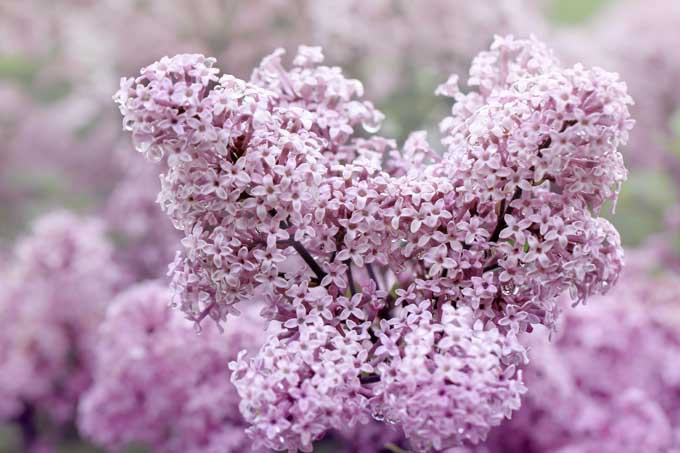Small lilacs have the same floral bounty and fragrance for which makes the species popular, but these versions are finer textured and more graceful than their larger siblings. Because of their fragrant spring display, these smaller versions may be planted close to the house, beside a veranda or as a feature in a lawn. They also work great as hedges or focal points in the “stuffed to the gills” cottage style. The tallest of these shrubs is only 2 meters. The pink to pale purple blooms appear a bit later in spring than those of common varieties.
The small, oval leaves are not bothered by powdery mildew, making small lilacs an attractive option in areas where powdery mildew disfigures common lilacs each summer.
Cultivars
‘Little leaf’ lilac grows 2 meters tall and twice as wide, offering a spreading habit unusual in other cultivars. In late spring, the densely foliaged plant bursts forth with short, upright spikes of red-budded, light pink flowers. The pale lavender blooms of Cut-leaf Lilacs make lovely companions to the white-flowered Fragrant Snowball (Viburnum carlecephalum) or a Kousa Dogwood. For contrast, plant ‘Black Knight’ Butterfly Bush where its purple blooms arch strikingly over the blooms of the small lilacs. The name ‘Korean Lilac’ covers several shrubs with profuse blooms whose names may appear on labels as S. patula, S. palibiniana or S. velutina. These are slow-growing, dense plants, about 1.5 meters tall and wide. Their purple buds produce pale lavender blooms in 12 cm spikes. Unlike all other lilacs, the foliage of the Korean variety turns a showy, dark red in autumn. For a lavishly flowering hedge, set Korean lilacs in a row. A bit of trimming will keep the hedge uniform, but not give it a sheared look. You can also use it as a flowering accent among other flowering shrubs and perennials. You can find it at Nature Hills Nursery. Of similar height and spread is Syringa x meyeri ‘Josee’. It has a profusion of lavender pink blooms on 10cm spikes in late spring, re-blooming in late summer to early autumn.
Plant S. meyeri on both sides of a doorway or garden gate to create a symmetrical accent and a delightful fragrant greeting for visitors. You can find it at Nature Hills Nursery.
Design Ideas
Planted with smaller flowering plants, small lilacs provide a colorful focal point. Surround with frothy white baby’s breath, creamy yellow ‘Hyperion’ daylilies, and lavender-blue catmint for a late spring bed full of color. We have an entire guide dedicated to helping you find the right lilac cultivar(s) for your garden here.
Create garden tapestries by combining with other flowering shrubs and trees, or by highlighting them in flower beds. Highlight the deep pink blooms by planting them in front of a Dwarf Red-leaf Plum. The Plum’s burgundy foliage provides a striking backdrop.
Planting
- Dig a hole just as deep as the plants’s root ball and twice the width. Mix a shovelful of compost into the soil from the hole.
- Remove the bush from its container. With your fingers, loosen the soil on the sides of the root ball and uncoil any circling roots.
- Place the plant in the planting hole, making sure the top of its root ball is level with the surface of the surrounding soil.
- Fill in around the root ball with compost enriched soil from the hole, firming it with you finger to prevent settling later.
- Form a rim of soil around the hole to create a watering basin. Water in well to establish good root-soil contact.
Purchasing tips
Buy bushes in containers in winter or early spring, before plants have started to grow leaves. Avoid buying large, twiggy plants. Do not buy plants in summer that has already developed leaves; they may not establish well.
Growing conditions
Full sun is vital. Small lilacs planted in sunny locations produce more blooms and more compact plants. Well-drained, good soil is also necessary. They prefer a neutral to somewhat alkaline soil and look their best when watered during dry periods.
Other tips
Cut flowering stems for lovely and fragrant bouquets. This is a good way to do light pruning to shape plants. Cut off spent flower clusters right after blooms fade. This prevents seeds from forming, saving plant energy for new growth. To make a hedge planting of Korean lilacs, set out plants in a row, spacing them 2 meters apart.
Seasonal tips
Early spring: Planting
Set out young plants as soon as the soil is warm and before the buds on the plants begin to open and develop leaves.
Summer: Pruning
Cut off any spent flowers and prune to shape the plants immediately after flowering, to keep the flowers from forming seeds. New plant growth during the summer will bear the next spring’s blooms.
Winter: Planting
In warmer climates, set out leafless, young plants whenever soil can be worked for optimum growing conditions. Plant will begin root growth during the winter months.
Plant ailments
Flattened, grey to grown bumps on stems are scale insects that suck plant juices from beneath their scaly protection. Heavy infestations of scale weaken plants and cause defoliation. © Ask the Experts, LLC. ALL RIGHTS RESERVED. See our TOS for more details. Uncredited photos: Shutterstock. Originally published January 4, 2015. Last updated May 24, 2017.




